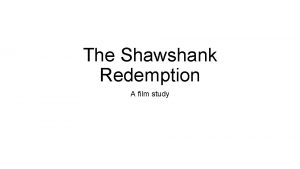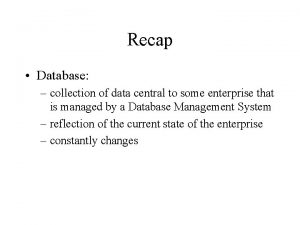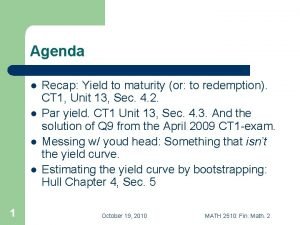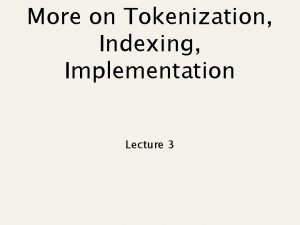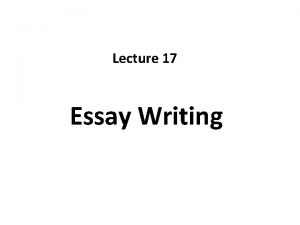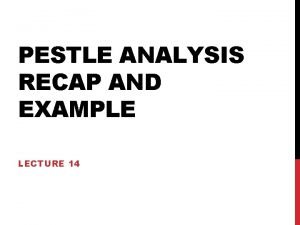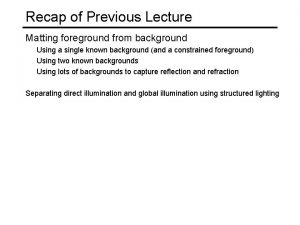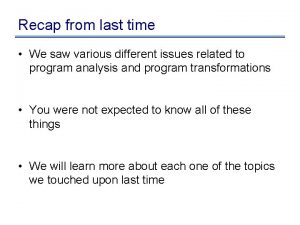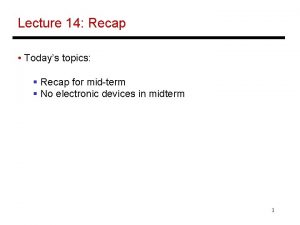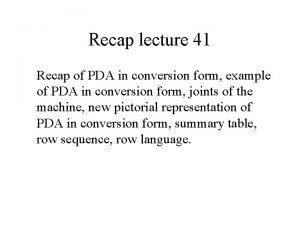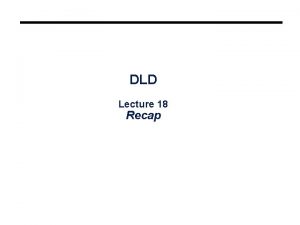RECAP 1 What is social support How does





































- Slides: 37

RECAP 1. What is social support? How does it explain resistance to social influence? 2. What is locus of control? How can we use it to explain resistance to social influence? 3. You fail your driving test… - How will someone with internal LOC explain their failure? - How will someone with external LOC explain their failure?

RSM Question…


Minority Influence Objectives: • To understand how the minority may influence the majority including reference to consistency, commitment and flexibility

Minority Influence • Minority influence refers to situations where one person or a small group of people (i. e. a minority) influences the beliefs and behaviours of other people. This is distinct from conformity where the majority is doing the influencing. • a minority rejects the established norm of the majority of group members and persuades the majority to move to the position of the minority • Minority influence is most likely to lead to internalisation – both public and private beliefs are changed by the process.

Minority Influence LO: To understand how the minority may influence the majority Starter: Choose one of the following minority views- Plan a 2 minute talk to try to convince the majority to agree with you. • Cabbage is much nicer than chocolate • Tidying your bedroom should be a legal requirement, failure of which would be punishable by fine. • Aliens have landed on earth • Miley Cyrus’ novels should win the Booker Prize for Literature • Hoop earrings and trakkie bottoms are the height of style • The next Prime Minister should be Simon Cowell • Marvel comics should be on the English Literature curriculum

What’s the difference between a minority and a majority?

The suffragette movement • Minority influence is generally felt only after a period of time, and tends to produce private acceptance of the views expressed by the minority. • A relatively small group of suffragettes argued strongly for the initially unpopular view that women should be allowed to vote. • The hard work of the suffragettes, combined with the justice of their case, finally led the majority to accept their point of view.

Can you think of any examples of minority influence? “where one person or a small group of people (i. e. a minority) influences the beliefs and behaviours of other people” 1. Sufragette movement 2. The right for civil partnerships 3. Persuading people to recycle because its good for the environment 4. Persuading people to sign up to donate/help charities

Minority Influence KEYWORD: A form of social influence where a minority of people (can be just one person) persuades the majority group to adopt their beliefs, attitudes or behaviours. This leads to internalisation. NOTE: This is NOT conformity! Serge Moscovici – investigated the power of minority influence and conducted a famous study (will come to this later). Consistency Commitment Flexibility Research suggests three main processes in minority influence.

Minority Influence Consistency The minority’s views must be consistent in their opposition to the majority. Diachronic– where a person maintains a consistent position over time Synchronic – where there is agreement among members of the minority group Consistency is “They all think this way – maybe they’ve got a point!” recognized as “They have been saying this for a while, ‘resolution, maybe they’ve got a point!”!” certainty, clarity of definition and It works so well because we all have the need to be consistent in our own views. coherence’

Minority Influence “WOW! Look what he has Commitment given up to express his view! He must really believe in The minority is what he's saying!” more powerful if they Augmentation principle: demonstrate their dedication If someone performs an action to a cause e. g. when there are known constraints, his or her motive perhaps through for acting are considered to be personal stronger - the will to act with sacrifice. consequences.

Minority Influence Flexibility The balance between consistency and flexibility. Being completely consistent all the time may actually give the impression that the minority is rigid and unbending – which is undesirable. Members of the minority group need to be prepared to amend their views and accept reasonable counterarguments. The Process of Change – the Snowball Effect The majority is influenced by the minority gradually – the original opinion is new and different. Following consistency, commitment and flexibility the individual becomes ‘converted’ – the more that are converted, the faster the rate of conversion.

The process of change… ‘snowball effect’

The process of change • All three of the factors (consistency, commitment, flexibility) make people think about the topic • Over time, people become ‘converted’ and switch from the minority to the majority – the more this happens, the faster the rate of conversion (the snowball effect) • Gradually the minority view becomes the majority and social change has occurred

Serge Moscovici – AO 3 Serge Moscovici first studied minority influence with his ‘blue slide, green slide’ study Pps were first given eye tests to ensure that they were not colour blind. They were then placed in a group consisting of four other participants and two confederates.

Moscovici et al (1969) • Pps were shown 36 slides which were clearly different shades of blue and asked to state the colour of each slide out loud. • In the first part of the experiment the two confederates answered green for each of the slides. They were completely consistent in their responses. • In the second part of the experiment they answered green 24 times and blue 12 times. In this case they were inconsistent in their answers. • Would the responses of the two confederates influence those of the four participants? In other words, would there be minority influence? • A control group was used for comparison with the experimental group therefore the factors expected to influence the experimental group are removed. The control group did not include confederates.


Results • Only 0. 25% of the control group’s responses were green, the rest were blue. • For the experimental group, 1. 25% of the participants’ answers were green when the confederates gave inconsistent answers (i. e. , 24 green, 12 blue). • This rose to 8. 42% responding with green when the confederates were consistent in their responses (i. e. , 36 green)

Conclusion • Moscovici’s experiment suggests that minorities can influence majorities. • However, it indicates that this influence is much more effective when the minority are consistent in their responses. • When the minority gave inconsistent answers, they were largely ignored by the majority. • Later research has largely confirmed these findings. • This study has drawn attention to three processes involved in minority influence

The process of change • All three of the factors (consistency, commitment, flexibility) make people think about the topic • Over time, people become ‘converted’ and switch from the minority to the majority – the more this happens, the faster the rate of conversion (the snowball effect) • Gradually the minority view becomes the majority and social change has occurred


Task… Recycling: it used to be the case that in this country very few people recycled. Anyone who did this may have been seen as being ‘a bit strange’. How did the minority activity of recycling become so widely accepted by the majority? Include all features of minority influence in your answer. C… C… F…

Task… Psychologists have discovered that minority influence can be an important social influence process in jury decision making. A jury of 12 people has to decide on the guilt or innocence of a defendant charged with murder. A vote is taken at the start of the Jury’s deliberations. 11 believe the defendant is guilty. The jury have to reach a unanimous decision, the discussion begins. After a few hours, another vote is taken. This time, all 12 jurors believe the defendant is not guilty. Using what you know about minority influence, explain how this change of opinion could have happened.

‘Twelve Angry Men’ • The film ‘Twelve Angry Men’ (1957) shows a good example of minority influence. • The film depicts a jury of twelve men who retire to consider a verdict - one juror manages to persuade eleven others to agree with him. • How might consistency, commitment and flexibility and snowball effect/augmentation principle have worked in this instance. 12 Angry Men

Minority Influence Consistency The minority’s views must be consistent in their opposition to the majority. Diachronic– where a person maintains a consistent position over time Synchronic – where there is agreement among members of the minority group Consistency is “They all think this way – maybe they’ve got a point!” recognized as “They have been saying this for a while, ‘resolution, maybe they’ve got a point!”!” certainty, clarity of definition and It works so well because we all have the need to be consistent in our own views. coherence’

Minority Influence “WOW! Look what he has Commitment given up to express his view! He must really believe in The minority is what he's saying!” more powerful if they Augmentation principle: demonstrate their dedication If someone performs an action to a cause e. g. when there are known constraints, his or her motive perhaps through for acting are considered to be personal stronger - the will to act with sacrifice. consequences.

Minority Influence Flexibility The balance between consistency and flexibility. Being completely consistent all the time may actually give the impression that the minority is rigid and unbending – which is undesirable. Members of the minority group need to be prepared to amend their views and accept reasonable counterarguments. The Process of Change – the Snowball Effect The majority is influenced by the minority gradually – the original opinion is new and different. Following consistency, commitment and flexibility the individual becomes ‘converted’ – the more that are converted, the faster the rate of conversion.

Evaluation… Can you think of any evaluation points for explaining minority influence? Hints: • Research support? • Tasks used in research? Are they artificial? • Validity? • Real life application?

‘Twelve Angry Men’ • The film ‘Twelve Angry Men’ (1957) shows a good example of minority influence. • The film depicts a jury of twelve men who retire to consider a verdict - one juror manages to persuade eleven others to agree with him. • How might consistency, commitment and flexibility and snowball effect/augmentation principle have worked in this instance. 12 Angry Men

The juror who believed in the defendant's innocence was in a minority of one. He remained consistent in his belief that the defendant was innocent. His argument would have been coherent and internally consistent and he would have maintained his view throughout the discussion. This would have attracted the attention of the other jurors and caused them to think more deeply about the issue. He showed commitment because he held an opinion that was unpopular and may even have attracted some derision, but he continued to hold it. This would – on the augmentation principle – have persuaded some of the other jurors that he was not acting out of self-interest. The chances are he would also have been flexible by acknowledging that those who considered the defendant guilty may have a point, but only on peripheral matters – above all else, the minority juror wold have held firmly to his central belief in the defendant's innocence. One by one, the majority of jurors would have changed their verdicts, with the momentum behind innocence gathering pace, according to the snowball effect, until the minority view became the verdict of the majority.

Evaluations Research support for consistency • Moscovici demonstrated that when the minority are consistent in their responses they can influence the majority. • When the minority gave inconsistent answers in Moscovici’s study, they were generally ignored by the majority. • Wood (1994) carried out a metaanalysis of 100 similar studies and found that minorities who were seen as being consistent were most influential. This suggests that consistency is a major factor in minority influence.

Evaluations Research support for depth of thought • Martin et al (2003) gave pps a message supporting a particular viewpoint and measured their support. One group of pps then heard a minority group endorsing the same view. Another group of pps heard a majority group endorsing the initial viewpoint. Pps were then exposed to a conflicting view and their support was measured again. • People were less willing to change their opinions to the new conflicting view if they had listened to a minority group than if they had listened to a majority group • This suggests that the minority message had been more deeply processed and had a more enduring effect

Evaluations Artificial tasks • Studies make clear a distinctions between majority and minority influence but the tasks are artificial - real-life situations are more complicated. This means that findings lack external validity and therefore have limited real-world applications • Most studies do not capture the commitment that minorities show towards their causes, including the social support that members give each other when majority hostility threatens to overwhelm them (e. g. Friends of the Earth, Gay Rights) The effect of the minority may not be apparent • People may be reluctant to admit their ‘conversion’ publically. Moscovici found higher agreement with the minority when pps wrote down their responses. This shows internalisation took place.

Could you answer the following question? Describe and evaluate research into minority influence. Refer to evidence in your answer. (12 marks – AS/16 marks A level)

Exam Question • What is meant by consistency, commitment and flexibility in relation to obedience? (3 marks)

Exam Question “Describe and evaluate research into minority influence” (12 marks)
 Summary of the shawshank redemption
Summary of the shawshank redemption Summary of chapter 8 the great gatsby
Summary of chapter 8 the great gatsby Price matching
Price matching What is the purpose of an iteration recap
What is the purpose of an iteration recap Recap intensity clipping
Recap intensity clipping 60 minutes recap
60 minutes recap Recap database
Recap database Bracket power rule
Bracket power rule Recap introduction
Recap introduction Recap introduction
Recap introduction Recap from last week
Recap from last week Discussion questions for the crucible act 1
Discussion questions for the crucible act 1 Pontius pilate the crucible
Pontius pilate the crucible Logbook recap example
Logbook recap example Ytm recap
Ytm recap Black box recap
Black box recap Fractions recap
Fractions recap Recap
Recap Without graphing identify the quadrant in which the point
Without graphing identify the quadrant in which the point Recap indexing scans
Recap indexing scans Lets have a recap
Lets have a recap Recap poster
Recap poster Public transportation essay
Public transportation essay Ldeq recap
Ldeq recap Romeo and juliet act 1 summary
Romeo and juliet act 1 summary Recap accounting
Recap accounting Example of recap
Example of recap Let's recap
Let's recap Let's recap
Let's recap Foil method dihybrid cross
Foil method dihybrid cross Recap background
Recap background Briefly summarise
Briefly summarise Saw recap
Saw recap Briefly recap
Briefly recap Social thinking and social influence in psychology
Social thinking and social influence in psychology Social thinking social influence social relations
Social thinking social influence social relations Major and minor ideas
Major and minor ideas Usetransition
Usetransition
